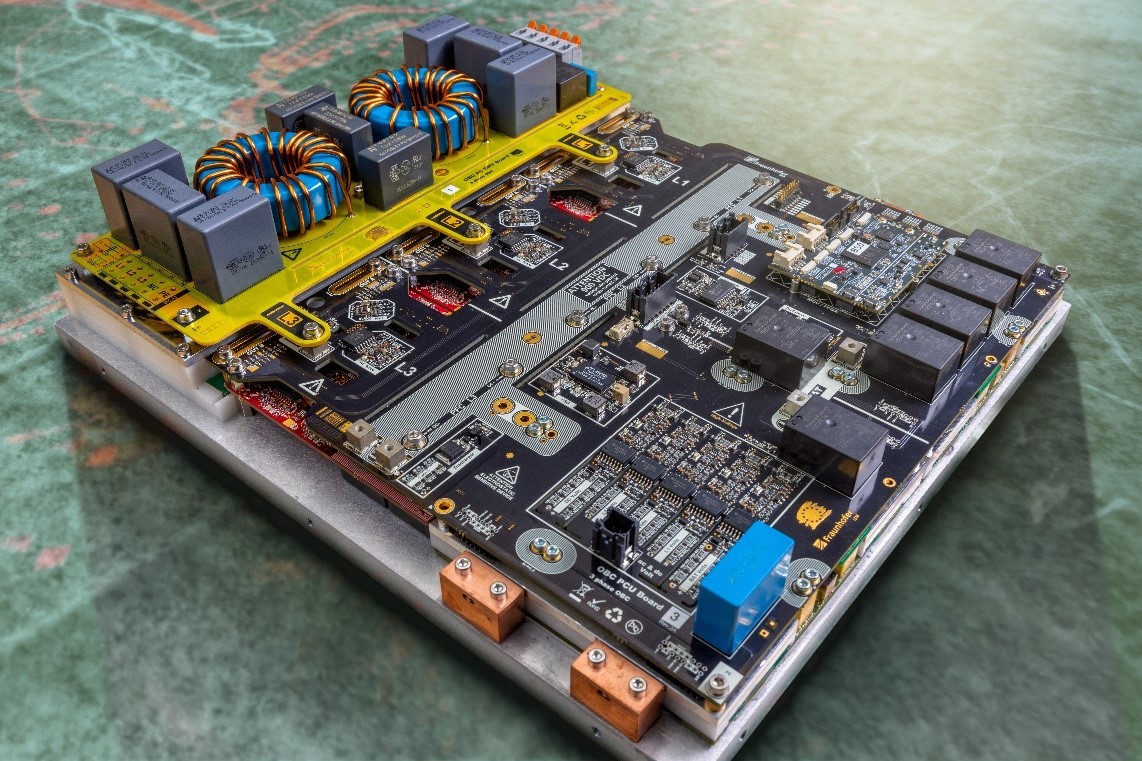Sign up for daily news updates from CleanTechnica on email. Or follow us on Google News!
On-board chargers are the great equalizers for electric vehicle charging — and can be a game-changer for the future of e-mobility. Fraunhofer IZM has managed to bring together some of the most innovative ideas in power electronics to pave the way for a new generation of on-board chargers. Twice the performance at half the size, bidirectional capabilities, and efficiently machine-made: The resulting on-board charger is the economical ticket to the fast lane into the future.
Drivers lucky enough to find a high power charging (HPC) or other fast-charging stations can expect their electric cars to be charged and ready to go in around 15 to 30 minutes. That feat is made possible by the massive power packed into these chargers, with some types delivering up to 350 kW. And that power is delivered in DC form, just as electric vehicle batteries need. This means charging the batteries directly without need for an on-board charger.

Not so with AC chargers, which are by far the more common type. They range from the common household socket found in most garages, offering up to 3 kW on a single phase of AC current. More promisingly, three-phase AC current from regular public e-vehicle charging points or domestic wallbox-type chargers can charge batteries with up to 22 kW, allowing the batteries of many cars to be filled completely in about four hours. However, many of the e-vehicles currently in use are designed to take in a maximum of 11 kW – a bottleneck created by the on-board charger (or OBC) they are fitted with. Current OBCs are typically made from a number of separate components, including large coils, that are often made and assembled manually and take up a lot of space in the vehicle. Many electric car makers offer an optional upgrade from 11 to 22 kW, either by fitting a second OBC or using a larger module. Both options come at a premium, both in cost and space, and most OBC work only unidirectionally, that is, only for charging the car battery. They could not feed stored power back into the grid or allow parked electric cars to act as a type of buffer for domestic solar power systems. The promise of electric vehicles coming to the rescue of the green energy transition as a distributed energy storage network remains a pipe dream with the old technology.
Sinus amplitude converter with gallium nitride semiconductors for speeds above 1 MHz
Breaking through this technological barrier meant that Fraunhofer IZM had to develop not one, but several new components and find a way to fit them together in a tiny package. One key component is a sinus amplitude converter (SAC), a resonant high-frequency transformer. Its primary mission is to ensure that the car battery is galvanically isolated from the public grid, because the parasitic earth currents created by the on-board capacitors could cause a ground fault in the circuit and stop the system from working. The innovative part of the new SAC is the gallium nitride (GaN) switches used in the Fraunhofer IZM design – novel, high-performance semiconductors with a wide bandgap that make it possible to switch the converters at a frequency of 1.3 MHz or 1.3 million times per second. Oleg Zeiter, who oversaw Fraunhofer IZM’s work on the new OBC, explains: “These high frequencies mean that we can totally rethink how we design the module.” This has a direct effect on another essential component: the PFC choke.
PFC inductor – Flat coils, machine-made
An OBC has one other key component, called the Power Factor Correction (PFC). It acts as the bridge with the public grid and gives the incoming alternating current a stable sinus shape at – depending on the local grid – 50 or 60 Hz. To do so, it uses chokes, a very bulky and very costly part in the conventional OBC designs. Fraunhofer IZM now uses a flat PFC inductor designed in circuit board form that has four magnetically coupled coils on a shared ferrite core. The PFC choke is not only much smaller; it can also be made by machine, instead of by hand. The planar design means that the choke can only generate lower inductivity, but this is no issue for the PFCs fitted with SiC switches and working at 140 KHz. “The low inductivity does not pose a problem for us, because we ramped up the switching frequency,” Oleg Zeiter explains. “Because we only ever switch on the current for an extremely brief moment in time, it never reaches high amperage, even at low inductivity – all thanks to the quick switching.”
The smart packaging and interconnection techniques employed by Fraunhofer IZM finally allowed the Institute to create an OBC that is a mere three cubic decimeters in volume: half the size of conventional OBC, but with double the charging capacity at 22 kW. “In essence, we are just working with one big circuit board. Our packaging solutions mean that we can have a machine fit everything we need on this board,” Oleg Zeiter says. In practice, this means a major reduction in production cost.
But these are not the only advantages of the new OBCs: The module can accommodate 400 and 800 V batteries and works at more than 97 percent efficiency. And the new OBC can let currents flow in both directions, from the grid to the battery and back again. This means that one of the basic questions of the energy transition has been resolved, at least from a technical standpoint, a feat made possible with support from the ECSEL JU initiative (Electronic Components and Systems for European Leadership Joint Undertaking) as part of the Horizon 2020 research and innovation program.
Anybody interested in this system and its combination of different technical tricks can see it up close from 11 to 13 June at Nuremberg’s PCIM Europe expo, the international expo for power electronics. The Fraunhofer IZM booth (hall 5, booth 300) will host the premiere for the new on-board charger.
By Christoph Hein. Courtesy of Fraunhofer IZM.
Have a tip for CleanTechnica? Want to advertise? Want to suggest a guest for our CleanTech Talk podcast? Contact us here.
Latest CleanTechnica.TV Videos
[embedded content]
Advertisement
CleanTechnica uses affiliate links. See our policy here.
- SEO Powered Content & PR Distribution. Get Amplified Today.
- PlatoData.Network Vertical Generative Ai. Empower Yourself. Access Here.
- PlatoAiStream. Web3 Intelligence. Knowledge Amplified. Access Here.
- PlatoESG. Carbon, CleanTech, Energy, Environment, Solar, Waste Management. Access Here.
- PlatoHealth. Biotech and Clinical Trials Intelligence. Access Here.
- Source: https://cleantechnica.com/2024/06/07/bidirectional-on-board-chargers-smaller-faster-cheaper/




